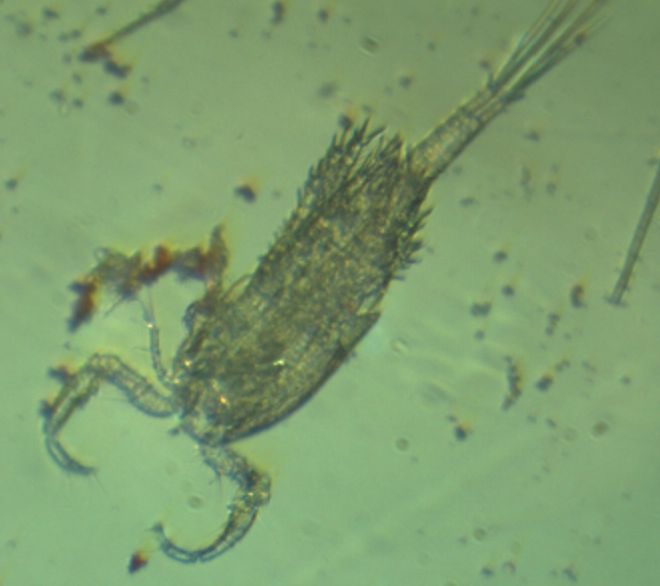Waters are more polluted than tests say: Standard toxicity analyses come up short

The scientists observed several species in the contaminated water body, including the less standard species for these tests, such as mini-snails and copepods. Photo: Hasenbein
If a small crustacean does not grow properly, this can affect its reproduction. And if it is no longer able to move normally, it cannot flee from predators or from changing temperatures, which eventually has a fatal outcome. In scientific research, these effects are referred to as “sublethal effects”.
However, worldwide standard methods of pesticide analysis and the risk assessments associated with them only consider the lethal (deadly) effects. For the first time, three studies published in “Ecotoxicology”, “Environmental Science and Pollution Research” and “Environmental Toxicology and Chemistry” demonstrate the sublethal effects on swimming behavior and growth, caused by widely used pesticides on the animals being studied.
Moreover, the results indicate that the substances influence the underwater world for weeks, even if they are no longer detectable using standard methods.
Pesticides become more toxic as a combined package
Another factor is the mix of pesticides: “We looked at the insecticides not individually, but as a mixture, in order to investigate their interaction with one another”, explains lead author Dr. Simone Hasenbein. “In addition, we observed several species in the contaminated water body, including the less standard species for these tests, such as mini-snails and copepods.”
The tests took place over a period of ten days in the laboratory and also for six months in the field. Eventually, significantly negative effects resulting from the combined pesticide pollution in the water were found for twelve of the 15 small invertebrates and ten of the 16 zooplankton species.
“Another point that was considered was how long the insecticide remained detectable in water”, was Dr. Hasenbein’s explanation of the method – “thus, one of the three substances was still detectable after six weeks.”
A clear result delivered by a combination of study series
• Firstly, the laboratory tests provided an indication of the concentrations at which the contaminants influence the growth and swimming behavior of the organisms.
• The field studies proved the long-term effects on an entire ecosystem, its food web and its community structures.
The negative effects on aquatic ecosystems could only be pinned down once all the results were combined. Since the microorganisms being studied can be influenced by the pesticides for much longer than these substances remain detectable, this also leads to the conclusion that bodies of water are far more polluted than all previous research had demonstrated.
Sublethal effects as alarm signals
The changes in the animals which are detectable from their swimming behavior, growth or weight, and which eventually lead to their death (sublethal), are an important indicator of this. To date, however, there is no valid scale showing the point from which, for example, a delay in growth has a fatal outcome for the animal.
Therefore, study author Dr. Hasenbein is advocating this approach in particular: “Sublethal endpoints need to be integrated into the methods used in ambient water monitoring, to allow long-term negative effects on aquatic ecosystems to be detectedreliably, even when the pesticide concentrations in the water are low“, says the scientist.
“A crustacean population which is exposed to low-level contaminant pollution could be more susceptible to invasive species, changes in water temperature or different salt concentrations, because the permanent, low-level pesticide contamination increases stress on the animals.“ This is an important aspect, especially in the light of climate change, and should therefore be taken into consideration in future ecotoxicologic assessments.
Publications:
Hasenbein S, Lawler SP, Geist J, Connon RE.: A long-term assessment of pesticide mixture effects on aquatic invertebrate communities. Environmental Toxicology and Chemistry, 13.11.2015. DOI: 10.1002/etc.3187
http://onlinelibrary.wiley.com/doi/10.1002/etc.3187/full
Hasenbein S, Connon RE, Lawler SP, Geist J.: A comparison of the sublethal and lethal toxicity of four pesticides in Hyalella azteca and Chironomus dilutus, Environmental Science and Pollution Research International, 2015 Aug;22(15):11327-39. doi: 10.1007/s11356-015-4374-1. http://link.springer.com/article/10.1007%2Fs11356-015-4374-1
Hasenbein S, Lawler SP, Geist J, Connon RE: The use of growth and behavioral endpoints to assess the effects of pesticide mixtures upon aquatic organisms. Ecotoxicology 24:746-759, 29.01.2015. DOI: 10.1007/s10646-015-1420-1
http://www.ncbi.nlm.nih.gov/pubmed/25630500
Contact:
Dr. Simone Hasenbein
Technical University of Munich
Chair of Aquatic Systems Biology/
University of California Davis, Dept. of Anatomy, Physiology and Cell Biology
Tel: +1 530 752 3141
Email: shasenbein@ucdavis.edu
Prof. Dr. Jürgen Geist
Chair of Aquatic Systems Biology
Department of Ecology and Ecosystem Management
Mühlenweg 22
D-85354 Freising
Germany
Tel.: +49/8161/71.3947
Email: geist@wzw.tum.de
http://www.tum.de/en/about-tum/news/press-releases/short/article/32771/
Media Contact
All latest news from the category: Ecology, The Environment and Conservation
This complex theme deals primarily with interactions between organisms and the environmental factors that impact them, but to a greater extent between individual inanimate environmental factors.
innovations-report offers informative reports and articles on topics such as climate protection, landscape conservation, ecological systems, wildlife and nature parks and ecosystem efficiency and balance.
Newest articles

Biophysics: Testing how well biomarkers work
LMU researchers have developed a method to determine how reliably target proteins can be labeled using super-resolution fluorescence microscopy. Modern microscopy techniques make it possible to examine the inner workings…

Making diamonds at ambient pressure
Scientists develop novel liquid metal alloy system to synthesize diamond under moderate conditions. Did you know that 99% of synthetic diamonds are currently produced using high-pressure and high-temperature (HPHT) methods?[2]…

Eruption of mega-magnetic star lights up nearby galaxy
Thanks to ESA satellites, an international team including UNIGE researchers has detected a giant eruption coming from a magnetar, an extremely magnetic neutron star. While ESA’s satellite INTEGRAL was observing…





















